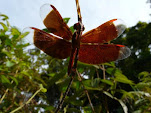The system runs basically along these lines: two winter visits, minimum 1 hour each, one in the early winter and one in the late winter. Breeding is covered by the same system, one visit in the earlier spring and one in the later spring/early summer. There are options to continue on for longer and gain more detail about the use of the tetrad by the birds there, but those are the minima. Pretty simple, really!
This morning's visit was to a fairly uniform area of farmland near home. Most of the fields are pasture, winter cereals or stubbles, and the bulk of the hedges are cropped fairly tight with flails over the autumn. Despite this, I managed to find a respectable 28 species in the hour's visit, including Woodlark, Red-legged Partridge and Kingfisher. I missed out on at least 8-10 species that I know will occur in the area, so some further roaming will be required to confirm their presence.
Other interesting finds: a rubber dragonfly in the hedge, some late Red Admiral butterflies taking advantage of the ivy nectar and a fly-tipped washing machine...




No comments:
Post a Comment